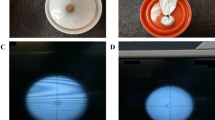Abstract
The objective of this study was to compare the results of shock wave lithotripsy (SWL) between patients treated with optical coupling control (OCC) and those treated with “blind” coupling during SWL to treat renal stones. Enrolled in the study were patients with urinary stones who underwent SWL between January 2014 and February 2015. The lithotripter used in the study was an electromagnetic Dornier Compact Delta II UIMS. The closed envelope method was used to randomize the enroled patients to OCC (Group A) or “Blind” coupling group (Group B). The stone-free rates (SFRs) were determined using KUB film with or without ultrasonography after 3 months. Treatment failure was defined as radiologically confirmed persistence of the stone with no fragmentation after second SWL sessions. Complications during the intraoperative or post-operative periods were recorded. A total of 336 patients satisfied the inclusion criteria for the study, of which 169 patients were treated in the Group A and 167 in the Group B. There was no significant difference in patient and stone characteristics between the two groups (Table 1). The locations of treated stones are shown in Table 2. The treatment results were stratified by stone location in Table 3, significant differences existed in all treatment results between the two groups (P < 0.05). The overall stone-free rates after 3 months were 78.2 % for kidney stones and 81.7 % for ureteral stones in patients from Group A. The corresponding SFRs for patients in Group B were 62.8 and 67.9 % for stones in the kidneys and ureters, respectively. There were statistical differences in these results between the two groups (P < 0.05). The lithotripter with OCC had excellent shock wave transmission properties with the least possible loss of energy; it can lead to the optimization of SWL treatment outcome and reduce the incidence of SW-induced adverse effects. We are confident that the OCC used in this study should be a standard feature in future lithotripters.


Similar content being viewed by others
References
Jain A, Shah TK (2007) Effect of air bubbles in the coupling medium on efficacy of extracorporeal shock wave lithotripsy. Eur Urol 51:1680–1687
Bohris C, Roosen A, Dickmann M et al (2012) Monitoring the coupling of the lithotripter therapy head with skin during routine shock wave lithotripsy with a surveillance camera. J Urol 187(1):157–163
Tailly GG, Tailly-Cusse MM (2014) Optical coupling control: an important step toward better shock wave lithotripsy. J Endourol 28:1368–1373
Chaussy C, Tailly GG, Forssmann B et al (2013) Extracorporeal shockwave lithotripsy in a nutshell. In: Chaussy C, Tailly G eds. Booklet presented to European Association of Urology.
Tailly GG (2013) Optical coupling control in SWL: first clinical experience. Poster MP07–13 presented at World Congress of Endourology; October 22–26, New Orleans
Lingeman JE, McAteer JA, Gnessin E, Evan AP (2009) Shock wave lithotripsy: advances in technology and technique. Nature Rev Urol 6:660–670
Rassweiler JJ, Knoll T, Kohrmann KU, McAteer JA et al (2011) Shock wave technology and application: an update. Eur Urol 59:784–796
Bergsdorf T, Chaussy C, Thueroff S (2010) Coupling gel viscosity: a relevant factor for efficient shock wave coupling in SWL. J Urol 183(suppl):e704
Pishchalnikov YA, Neucks JS, VonDerHaar RJ et al (2006) Air pockets trapped during routine coupling in dry head lithotripsy can significantly decrease the delivery of shock wave energy. J Urol 176:2706–2710
Bergsdorf T, Chaussy C, Thueroff S (2008) Energy coupling in extracorporeal shock wave lithotripsy—the impact of coupling quality on disintegration efficacy. J Endourol 22:A161
Bergsdorf T, Chaussy C, Thueroff S (2009) The significance of accurate shock wave coupling in extracorporeal shock wave lithotripsy. J Endourol 23:1042
Bohris C (2010) Quality of coupling in ESWL significantly affects the disintegration capacity—how to achieve good coupling with ultra-sound gel. In: Chaussy C, Haupt G, Jocham D, Köhrmann KU (eds) Therapeutic energy applications in urology II: standards and recent developments. Thieme; Stuttgart, Germany, pp 61–64
Chaussy CG, Fuchs GJ (1989) Current state and future developments of noninvasive treatment of human urinary stones with extracorporeal shock wave lithotripsy. J Urol 141(3 Pt 2):782–789
Clayman RV, McClennan BL, Garvin TJ et al (1989) Lithostar: an electromagnetic acoustic shock wave unit for extracorporeal lithotripsy. In: Lingeman JE (ed) Shock wave lithotripsy 2: urinary and biliary lithotripsy. Springer, Berlin, New York, NY, pp 403–409
McClain PD, Lange JN, Assimos DG (2013) Optimizing shock wave lithotripsy: a comprehensive review. Rev Urol 15(2):49–60
Neucks JS, Pishchalnikov YA, Zancanaro AJ et al (2008) Improved acoustic coupling for shock wave lithotripsy. Urol Res 36:61–66
Li G, Williams JC Jr, Pishchalnikov YA, McAteer JA (2012) Size and location of defects at the coupling interface affect lithotripter performance. BJU Int 110:871–877
Bohris C, Jensen H, Bayer T et al (2006) A new integrated ultrasound system for shockwave lithotripsy. J Endourol 20:863
Neucks JS, Pishchalnikov YA, Zancanaro AJ et al (2008) Improved acoustic coupling for shock wave lithotripsy. Res Urol 36(1):61
Author information
Authors and Affiliations
Corresponding author
Ethics declarations
Conflict of interest
Jian Lin Lv declares that he has no conflict of interest. All procedures performed in studies involving human participants were in accordance with the ethical standards of the institutional and/or national research committee and with the 1964 Helsinki declaration, and its later amendments or comparable ethical standards.
Rights and permissions
About this article
Cite this article
Lv, J.L. A new optical coupling control technique and application in SWL. Urolithiasis 44, 539–544 (2016). https://doi.org/10.1007/s00240-016-0874-9
Received:
Accepted:
Published:
Issue Date:
DOI: https://doi.org/10.1007/s00240-016-0874-9




